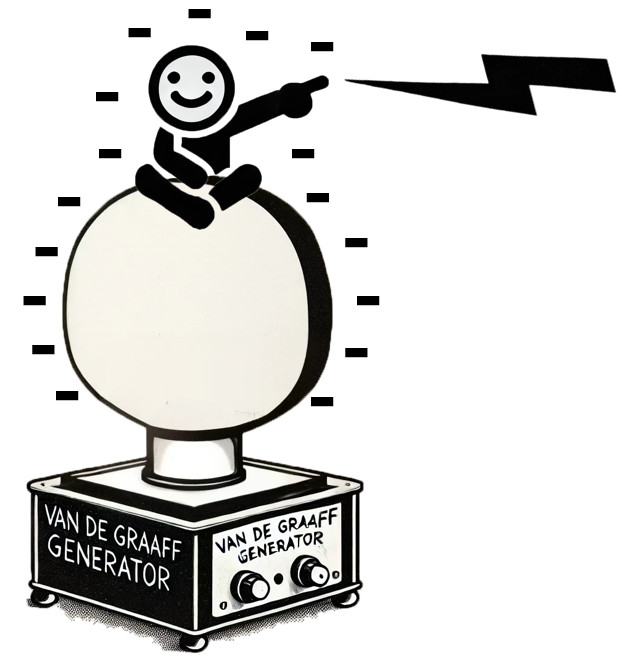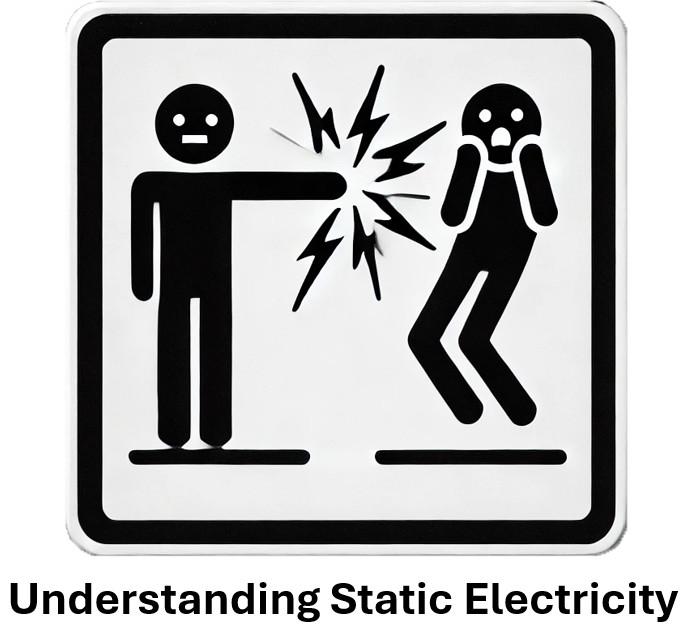Static electricity has a way of sneaking into our lives—whether it’s the sting of a doorknob shock, the crackle of a sweater pulled over your head, or the mischievous satisfaction of zapping a friend. Understanding static electricity isn’t just about avoiding these shocks; it’s about uncovering the fascinating science that makes them possible. Let’s explore how static electricity works, how to build up a charge (for fun or education), and how it relates to larger systems like the Van de Graaff generator.
What is Static Electricity?
Static electricity occurs when there’s an imbalance of charges on an object. This typically happens through friction, which transfers electrons from one material to another. For instance, rubbing a balloon on your hair leaves the balloon negatively charged (gaining electrons) and your hair positively charged (losing electrons). (Learn about charging here)
This charge imbalance creates an electric field around the charged object, which can induce an opposite charge in nearby objects. When the electric field becomes strong enough to ionize the surrounding air, electrons jump across the gap, creating the spark and sting of a static shock. Want more details? (Check out Stickman Physics’ page on electric fields)
Building Charge: How to Become a Human Van de Graaff Generator

Have you ever wanted to become a walking zapping machine? Building a static charge is surprisingly easy (and fun). Here’s how to turn yourself into a human Van de Graaff generator:
- Dry Environment is Key
Moisture in the air dissipates charges, so static electricity builds more easily in dry conditions. Think winter, when the air is naturally dry, or create your own dry zone by cranking up the heat. - Insulating Materials
Rubber-soled shoes and synthetic fabrics like wool or polyester help retain your charge. These insulators work just like the insulating dome of a Van de Graaff generator, keeping electrons from escaping. - Friction is Your Friend
Rub a balloon on your hair or shuffle your feet across a carpet. This friction creates a separation of charge by transferring electrons to your body. Now you’re a walking capacitor, ready to zap. - Isolate Yourself
Avoid touching anything conductive. Just as a Van de Graaff generator isolates its dome to prevent charges from grounding, you need to stay insulated to maintain your charge.
Why Shocks Happen
A shock occurs when the electric field around a charged object becomes strong enough to ionize the surrounding air, creating a pathway for electrons to jump. Here’s how it works:
- Charge Separation: Friction creates an imbalance of charges.
- Electric Field: The charge generates an electric field, inducing an opposite charge in nearby conductive objects.
- Ionization: The air becomes ionized, allowing electrons to flow.
- Discharge: Electrons leap across the gap to neutralize the charge difference, creating a visible spark.
This same principle powers lightning during thunderstorms—your static shock is just a miniaturized version.
Van de Graaff Generators: Be the Cloud in Your Thunderstorm
A Van de Graaff generator is a larger, controlled version of what happens when you shuffle across a carpet. A rubber belt transfers electrons to a metal dome, which is insulated to prevent charge dissipation. The dome builds up a massive charge, creating an electric field strong enough to ionize the surrounding air and produce visible sparks.
When you charge yourself by friction and stay insulated, you’re essentially mimicking a Van de Graaff generator. The sensation you feel as you approach a metal object—the electric field—is the same as standing near a highly charged generator. Learn more about Van de Graaff generators here.
Why Static Electricity is More Common in Winter
Static shocks are more frequent in winter because cold air holds less moisture. Moist air acts as a conductor, allowing charges to dissipate. In dry winter conditions, there’s no escape for those pesky electrons, so they build up on your body, waiting for their moment to strike.
Fun Experiments with Static Electricity
- Balloon Tricks
Rub a balloon on your hair and watch it stick to a wall. The friction transfers electrons to the balloon, giving it a negative charge, while the wall becomes positively charged through induction. - Moving Cans
Charge a plastic comb by running it through your hair, then hold it near an empty soda can. The can will roll toward the comb due to the attractive force between opposite charges. - Van de Graaff Fun
If you have access to a Van de Graaff generator, place your hands on the dome and watch your hair stand on end as charges repel each other.
Understanding Static Electricity: A Shocking Disclaimer
While static electricity is fun to experiment with, always use caution. Avoid zapping people with pacemakers or damaging electronics with excessive discharge. Stick to harmless pranks and educational experiments.
For more on understanding static electricity, visit the Stickman Physics Electrostatics Static Page. Whether you’re zapping friends or learning about electric fields, this science will spark your curiosity (and your finger).

